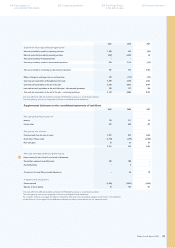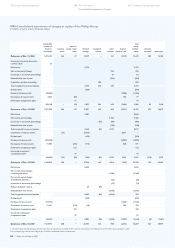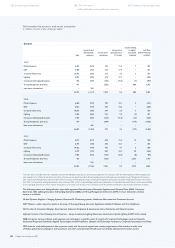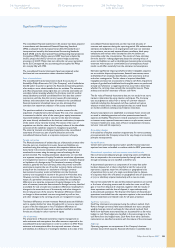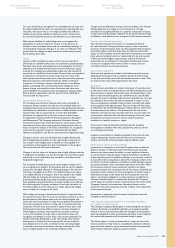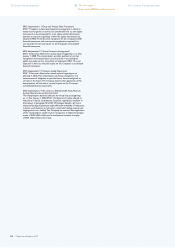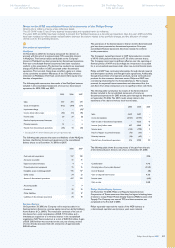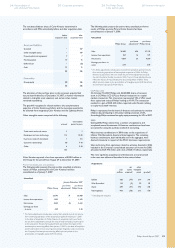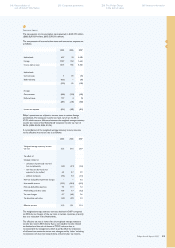Philips 2007 Annual Report Download - page 203
Download and view the complete annual report
Please find page 203 of the 2007 Philips annual report below. You can navigate through the pages in the report by either clicking on the pages listed below, or by using the keyword search tool below to find specific information within the annual report.
Philips Annual Report 2007 209
Impairment of goodwill
Goodwill is not amortized but tested for impairment annually and
whenever impairment indicators require. The Company identied its
cash generating units as one level below that of an operating sector.
Cash ows at this level are substantially independent from other cash
ows and this is the lowest level at which goodwill is monitored by
the Board of Management. The Company performed and completed
annual impairment tests in the same quarter of all years presented in
the consolidated statements of income. A goodwill impairment loss is
recognized in the income statement whenever and to the extent that
the carrying amount of a cash-generating unit exceeds the recoverable
amount of that unit.
Share capital
Incremental costs directly attributable to the issuance of shares are
recognized as a deduction from equity. When share capital recognized
as equity is repurchased, the amount of the consideration paid, including
directly attributable costs, is recognized as a deduction from equity.
Repurchased shares are classied as treasury shares and are presented
as a deduction from stockholders’ equity.
Debt and other liabilities
Debt and liabilities other than provisions are stated at amortized cost.
However, loans that are hedged under a fair value hedge are remeasured
for the changes in the fair value that are attributable to the risk that
is being hedged.
Provisions
Provisions are recognized if, as a result of a past event, the Company
has a present legal or constructive obligation that can be estimated
reliably, and it is probable that an outow of economic benets will
be required to settle the obligation.
Provisions are measured at the present value of the expenditures
expected to be required to settle the obligation using a pre-tax
discount rate that reects current market assessments of the time
value of money and the risks specic to the obligation. The increase in
the provision due to passage of time is recognized as interest expense.
The Company accrues for losses associated with environmental
obligations when such losses are probable and can be estimated reliably.
Measurement of liabilities is based on current legal and constructive
requirements. Liabilities and expected insurance recoveries, if any,
are recorded separately. The carrying amount of liabilities is regularly
reviewed and adjusted for new facts and changes in law.
Restructuring
The provision for restructuring relates to the estimated costs of
initiated reorganizations that have been approved by the Board of
Management, and which involve the realignment of certain parts of
the industrial and commercial organization. When such reorganizations
require discontinuance and/or closure of lines of activities, the
anticipated costs of closure or discontinuance are included in
restructuring provisions. A liability is recognized for those costs only
when the Company has a detailed formal plan for the restructuring
and has raised a valid expectation with those affected that it will carry
out the restructuring by starting to implement that plan or announcing
its main features to those affected by it.
Guarantees
The Company recognizes a liability for the fair value of the obligation
at the inception of a nancial guarantee contract. The guarantee is
subsequently measured at the higher of the best estimate of the
obligation or the amount intially recognized.
IFRS accounting standards adopted as from 2007
IFRS 7 ‘Financial instruments: Disclosures, and the complementary
Amendment to IAS 1, Presentation of Financial Statements – Capital Disclosure’
IFRS 7 introduced new disclosures relating to the nancial instruments.
This standard did not have any impact on the classication and
valuation of the Company’s nancial instruments.
IFRS 8 ‘Operating Segments’
The Company has adopted IFRS 8 Operating Segments in advance of
its effective date. IFRS 8 requires operating segments to be identied
on the basis of internal reports about components of the Company
that are regularly reviewed by the chief operating decision maker
in order to allocate resources to the segment and to assess its
performance. In contrast, the predecessor Standard (IAS 14 Segment
Reporting) required an entity to identify two sets of segments
(business and geographical), using a risks and rewards approach, with
the entity’s ‘system of internal nancial reporting to key management
personnel’ serving only as the starting point for the identication of
such segments. The identication of the Company’s reportable
segments has not changed due to the adoption of IFRS 8.
IFRIC Interpretation 7 ‘Applying the Restatement Approach under IAS 29,
Financial Reporting in Hyperinationary Economies’
IFRIC 7 provides guidance on how to apply the requirements of IAS
29 in a reporting period in which an entity identies the existence of
hyperination in the economy of its functional currency, when the
economy was not hyperinationary in the prior period. The adoption
of this interpretation did not have a material impact on the Company’s
consolidated nancial statements.
IFRIC Interpretation 8 ‘Scope of IFRS 2’
IFRIC 8 requires consideration of transactions involving the issuance
of equity instruments – where the identiable consideration received
is less than the fair value of equity instruments issued - to establish
whether or not they fall within the scope of IFRS 2. This interpretation
did not have a material impact on the Company’s consolidated
nancial statements.
IFRIC Interpretation 9 ‘Reassessment of Embedded Derivatives’
IFRIC 9 requires an entity to assess whether an embedded derivative
is required to be separated from the host contract and accounted for
as a derivative when the entity rst becomes a party to the contract.
Subsequent reassessment is prohibited unless there is a change in the
terms of the contract that signicantly modies the cash ows that
otherwise would be required under the contract, in which case
reassessment is required. The Company continuously assesses any
modications in the terms of the contracts and determined that the
adoption of this interpretation did not have an impact on the
Company’s consolidated nancial statements.
IFRIC Interpretation 10 ‘Interim Financial Reporting and Impairment’
IFRIC 10 prohibits impairment losses recognized in an interim period
on goodwill, investments in equity instruments and investments in
nancial assets carried at cost to be reversed at a subsequent balance
sheet date. The adoption of this interpretation did not have a material
impact on the Company’s consolidated nancial statements.
IFRS accounting standards effective as from 2008
A number of amendments and revisions to standards and
interpretations are not yet effective for the year ended December 31,
2007, and have not been applied in preparing these consolidated
nancial statements:
IAS 1 (Amendments) ‘Presentation of Financial Statements’
The amendments to IAS 1 becomes effective for annual reports
beginning on or after January 1, 2009. The amendments mainly
concern the presentation of changes in equity, in which changes
as a result of the transaction with shareholders should be presented
separately and for which a different format of the overview of the
changes in equity can be selected. Furthermore, an opening balance
sheet of the corresponding period is presented where restatements
have occurred.
IAS 23 (Amendment) ‘Borrowing costs’
The amendment to IAS 23, which becomes effective for annual reports
beginning on or after January 1, 2009, removes the option of immediately
recognizing as an expense borrowing costs that relate to assets that
take a substantial period of time to get ready for use or sale. The
Company assessed that this amendment will not have any impact
on the Company’s consolidated nancial statements as the Company
capitalizes borrowing costs relating to assets that take a substantial
period of time to get ready for use or sale.
IFRS 2 (Amendments) Share-based Payment
The amendments to IFRS 2, which become effective for annual reports
beginning on or after January 1, 2009, clarify the denition of vesting
conditions and the accounting treatment of cancellations by the
counterparty to a shared-based arrangement. The Company is currently
in the process of assessing the potential impact of the amendments.
IFRS 3 (Revised) Business Combinations and IAS 27 (Revised) Consolidated
and Separate Financial Statements
The revisions to IFRS 3 and IAS 27 are mandatory for business
combinations in annual reports beginning on or after July 1, 2009. The
revised standards result in a greater emphasis on the use of fair value,
focuses on changes in control as a signicant economic event and
focuses on what is given to the vendor as consideration, rather than
what is spent to achieve the acquisition. The revised standards resolve
many of the more contentious aspects of business combination
accounting by restricting options or allowable methods. The Company
has not yet determined the potential impact of these revisions.
Group nancial statements
Signicant IFRS accounting policies
Company nancial statements 250 Corporate governance246 Reconciliation of
non-US GAAP information 258 The Philips Group
in the last ten years 260
Investor information


